

Hotspots for biogenesis of small RNA molecules in plant cells discovered. Throughout their life, plants form leaves and side roots.
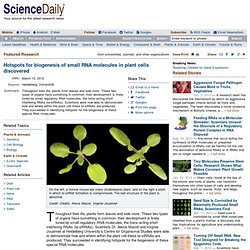
These two types of organs have something in common: their development is finely tuned by small regulatory RNA molecules, the trans-acting short interfering RNAs (ta-siRNAs). Scientists Dr. Alexis Maizel and Virginie Jouannet at Heidelberg University's Centre for Organismal Studies were able to demonstrate how and where within the plant cell these ta-siRNAs are produced. New technique sheds light on RNA. When researchers sequence the RNA of cancer cells, they can compare it to normal cells and see where there is more RNA.

That can help lead them to the gene or protein that might be triggering the cancer. But other than spotting a few known instigators, what does it mean? Is there more RNA because it's synthesizing too quickly or because it's not degrading fast enough? What part of the biological equilibrium is off? After more than a decade of work, researchers at the University of Michigan Comprehensive Cancer Center have developed a technique to help answer those questions.
The method involves a compound called bromouridine, which can be used to tag or label newly created RNA. On the other hand, the researchers can follow up the bromouridine labeling with a rinse with the chemical uridine for different periods of time. Early evolution of life: Study of ribosome evolution challenges 'RNA World' hypothesis. In the beginning -- of the ribosome, the cell's protein-building workbench -- there were ribonucleic acids, the molecules we call RNA that today perform a host of vital functions in cells.

And according to a new analysis, even before the ribosome's many working parts were recruited for protein synthesis, proteins also were on the scene and interacting with RNA. This finding challenges a long-held hypothesis about the early evolution of life. The study appears in the journal PLoS ONE. The "RNA world" hypothesis, first promoted in 1986 in a paper in the journal Nature and defended and elaborated on for more than 25 years, posits that the first stages of molecular evolution involved RNA and not proteins, and that proteins (and DNA) emerged later, said University of Illinois crop sciences and Institute for Genomic Biology professor Gustavo Caetano-Anollés, who led the new study.
Retrovirus in the human genome is active in pluripotent stem cells. A retrovirus called HERV-H, which inserted itself into the human genome millions of years ago, may play an important role in pluripotent stem cells, according to a new study published in the journal Retrovirology by scientists at UMass Medical School.
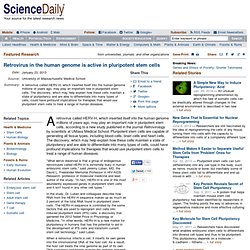
Pluripotent stem cells are capable of generating all tissue types, including blood cells, brain cells and heart cells. The discovery, which may help explain how these cells maintain a state of pluripotency and are able to differentiate into many types of cells, could have profound implications for therapies that would use pluripotent stem cells to treat a range of human diseases. "What we've observed is that a group of endogenous retroviruses called HERV-H is extremely busy in human embryonic stem cells," said Jeremy Luban, MD, the David L.
Freelander Memorial Professor in HIV/AIDS Research, professor of molecular medicine and lead author of the study. In the study, Dr. First artificial enzyme created by evolution in a test tube. There's a wobbly new biochemical structure in Burckhard Seelig's lab at the University of Minnesota that may resemble what enzymes looked like billions of years ago, when life on earth began to evolve -- long before they became ingredients for new and improved products, from detergents to foods and fuels.
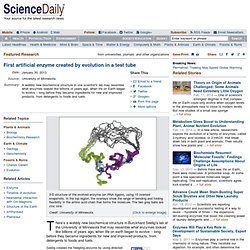
Seelig created the fledgling enzyme by using directed evolution in the laboratory. Working with colleague Gianluigi Veglia, graduate student Fa-An Chao, and other team members, he subsequently determined its structure, which made its debut December 9 as an advance online publication in Nature Chemical Biology. Turning off small RNA: New tool designed for breaking the epigenetic code. For the last dozen years, scientists have known that minuscule strings of genetic material called small RNA are critically important to our genetic makeup.
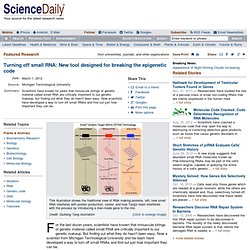
But finding out what they do hasn't been easy. Now a scientist from Michigan Technological University and his team have developed a way to turn off small RNAs and find out just how important they can be. When it comes to inheritance, DNA is just the half of it. What we are is also driven by the epigenetic world of RNA: the countless, twisting molecules that DNA churns out. RNA in turn transforms the amino acid soup in our cells into the proteins that are us -- and every other plant and animal on the planet, for that matter. New dinosaur fossil challenges bird flight origins theories. The discovery of a new bird-like dinosaur from the Jurassic period challenges widely accepted theories on the origin of flight.

Co-authored by Dr Gareth Dyke, Senior Lecturer in Vertebrate Palaeontology at the University of Southampton, the paper describes a new feathered dinosaur about 30 cm in length which pre-dates bird-like dinosaurs that birds were long thought to have evolved from. Over many years, it has become accepted among palaeontologists that birds evolved from a group of dinosaurs called theropods from the Early Cretaceous period of Earth's history, around 120-130 million years ago. Recent discoveries of feathered dinosaurs from the older Middle-Late Jurassic period have reinforced this theory. The new 'bird-dinosaur' Eosinopteryx described in Nature Communications this week provides additional evidence to this effect.
Cellular switches: From the RNA world to the 'modern' protein world. Heidelberg scientists have discovered the molecular mechanism of a G protein family.

G proteins play a central role in cellular signal processing. They are described as molecular switches that oscillate between 'on' and 'off', regulated by effectors. Computer sleuthing helps unravel RNA's role in cellular function. Computer engineers may have just provided the medical community a new way of figuring out exactly how one of the three building blocks of life forms and functions.
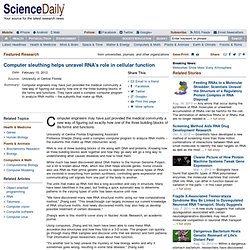
University of Central Florida Engineering Assistant Professor Shaojie Zhang used a complex computer program to analyze RNA motifs -- the subunits that make up RNA (ribonucleic acid). RNA is one of three building blocks of life along with DNA and proteins. Knowing how all three building blocks work together and how they go awry will go a long way to understanding what causes diseases and how to treat them.
While much has been discovered about DNA thanks to the Human Genome Project, not a lot is known about RNA, which like DNA helps encode genes. Some viruses also use RNA as their prime genetic source to replicate. RNA interference cancer treatment? Delivering RNA with tiny sponge-like spheres. For the past decade, scientists have been pursuing cancer treatments based on RNA interference -- a phenomenon that offers a way to shut off malfunctioning genes with short snippets of RNA.

However, one huge challenge remains: finding a way to efficiently deliver the RNA. Most of the time, short interfering RNA (siRNA) -- the type used for RNA interference -- is quickly broken down inside the body by enzymes that defend against infection by RNA viruses. "It's been a real struggle to try to design a delivery system that allows us to administer siRNA, especially if you want to target it to a specific part of the body," says Paula Hammond, the David H. A radar for ADAR: Altered gene tracks RNA editing in neurons. Jan. 4, 2012 — RNA editing is a key step in gene expression. Scientists at Brown University report in Nature Methods that they have engineered a gene capable of visually displaying the activity of the key enzyme ADAR in living fruit flies. To track what they can't see, pilots look to the green glow of the radar screen.
Simpler times: Did an earlier genetic molecule predate DNA and RNA? In the chemistry of the living world, a pair of nucleic acids -- DNA and RNA -- reign supreme. As carrier molecules of the genetic code, they provide all organisms with a mechanism for faithfully reproducing themselves as well as generating the myriad proteins vital to living systems. Yet according to John Chaput, a researcher at the Center for Evolutionary Medicine and Informatics, at Arizona State University's Biodesign Institute®, it may not always have been so. Chaput and other researchers studying the first tentative flickering of life on earth have investigated various alternatives to familiar genetic molecules.
These chemical candidates are attractive to those seeking to unlock the still-elusive secret of how the first life began, as primitive molecular forms may have more readily emerged during the planet's prebiotic era. Computer assisted design (CAD) for RNA. The computer assisted design (CAD) tools that made it possible to fabricate integrated circuits with millions of transistors may soon be coming to the biological sciences. Researchers at the U.S. Department of Energy (DOE)'s Joint BioEnergy Institute (JBEI) have developed CAD-type models and simulations for RNA molecules that make it possible to engineer biological components or "RNA devices" for controlling genetic expression in microbes. This holds enormous potential for microbial-based sustainable production of advanced biofuels, biodegradable plastics, therapeutic drugs and a host of other goods now derived from petrochemicals.
"Because biological systems exhibit functional complexity at multiple scales, a big question has been whether effective design tools can be created to increase the sizes and complexities of the microbial systems we engineer to meet specific needs," says Jay Keasling, director of JBEI and a world authority on synthetic biology and metabolic engineering. Built-in 'self-destruct timer' causes ultimate death of messenger RNA in cells. Researchers at Albert Einstein College of Medicine of Yeshiva University have discovered the first known mechanism by which cells control the survival of messenger RNA (mRNA) -- arguably biology's most important molecule. The findings pertain to mRNAs that help regulate cell division and could therefore have implications for reversing cancer's out-of-control cell division. The research was recently described in the journal Cell.
"The fate of the mRNA molecules we studied resembles a Greek tragedy," said the study's senior author, Robert Singer, Ph.D., co-director of the Gruss Lipper Biophotonics Center and professor and co-chair of anatomy and structural biology at Einstein. "Their lifespans are determined at the moment of their birth. " The study was carried out in yeast cells using advanced microscope technology developed previously by Dr. Long non-coding RNA prevents the death of maturing red blood cells. A long non-coding RNA (lncRNA) regulates programmed cell death during one of the final stages of red blood cell differentiation, according to Whitehead Institute researchers. This is the first time a lncRNA has been found to play a role in red blood cell development and the first time a lncRNA has been shown to affect programmed cell death. "Programmed cell death, or apoptosis, is very important, particularly in the hematopoietic (blood forming) system, where inhibition of cell death leads to leukemias," says Whitehead Institute Founding Member Harvey Lodish, who is also a professor of biology and a professor of bioengineering at MIT.
"We know a lot about the genes and proteins that regulate apoptosis, but this is the first example of a non-coding RNA that plays a role in blood cells. We would not be surprised to find this lncRNA or others like it upregulated in cancers. " Currently, little is known about the specific function of lncRNAs, despite their abundance in cells. Mechanisms cells use to remove bits of RNA from DNA strands. When RNA component units called ribonucleotides become embedded in genomic DNA, which contains the complete genetic data for an organism, they can cause problems for cells. It is known that ribonucleotides in DNA can potentially distort the DNA double helix, resulting in genomic instability and altered DNA metabolism, but not much is known about the fate of these ribonucleotides.
Acquired traits can be inherited via small RNAs. Columbia University Medical Center (CUMC) researchers have found the first direct evidence that an acquired trait can be inherited without any DNA involvement. The findings suggest that Lamarck, whose theory of evolution was eclipsed by Darwin's, may not have been entirely wrong. Cancer drug cisplatin found to bind like glue in cellular RNA. An anti-cancer drug used extensively in chemotherapy binds pervasively to RNA -- up to 20-fold more than it does to DNA, a surprise finding that suggests new targeting approaches might be useful, according to University of Oregon researchers. New technique gives precise picture of how regulatory RNA controls gene activity. A new technique developed by researchers at the Stanford University School of Medicine allows researchers to identify the exact DNA sequences and locations bound by regulatory RNAs.
This information is necessary to understand how the recently identified RNA molecules control the expression of neighboring and distant genes. The study offers a startling glimpse into the intricate world of gene expression and how RNA, once thought to be only a lowly cellular messenger, actively unlocks our DNA-based genome. "We used to have to just infer where these RNAs were acting based on their biological effects," said Howard Chang, MD, PhD, professor of dermatology. "But now we can identify precisely where on the chromatin they are binding. We've found that these sites are focal, numerous and sequence-specific. " Deciphering the role of regulatory RNAs is critically important to understand many cellular functions, including those involved in development, cancer and regeneration. New role for RNA interference during chromosomal replication discovered.
Team finds stable RNA nano-scaffold within virus core. Key function of enzyme involved in RNA processing described. Hitting moving RNA drug targets: New way to search for novel drugs.